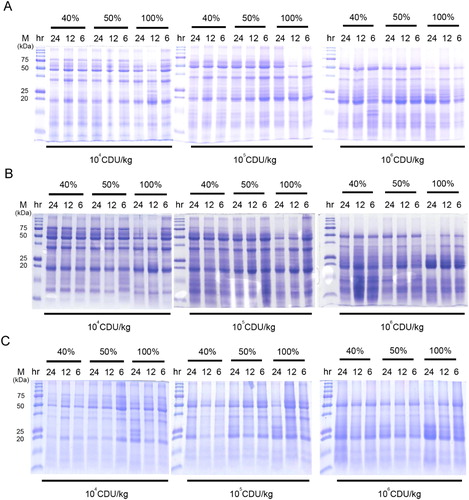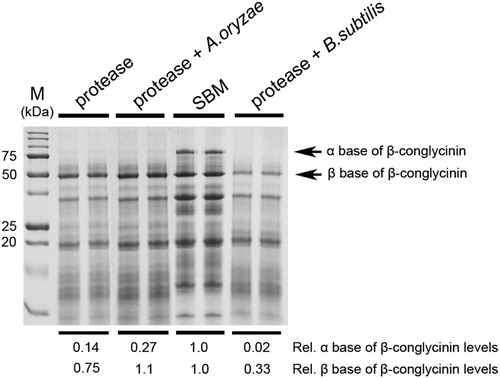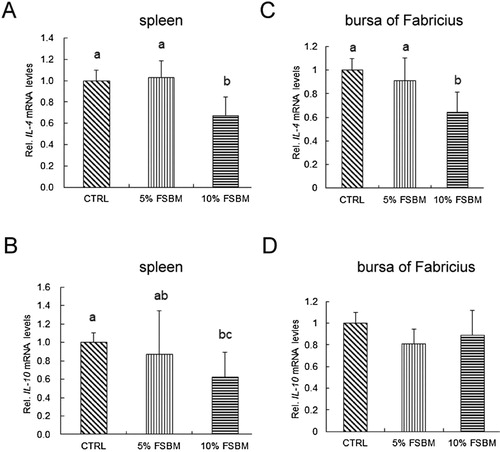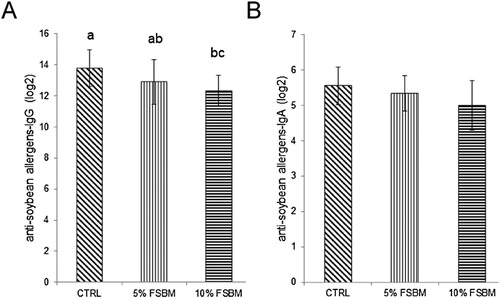Figures & data
Table 1. Nutrient composition of the basal diet.
Table 2. Primer sequences for quantitative reverse-transcription PCR.
Figure 1. Effect of protease and probiotics on the soy protein content of FSBM. (A) Effects of different protease activity (104, 105, and 106 CDU/kg), initial moisture (40%, 50%, and 100%), and fermentation durations (6, 12, and 24 h) on the soy protein content of FSBM. (B) Effects of different protease activity (104, 105, and 106 CDU/kg), initial moisture (40%, 50%, and 100%), and fermentation durations (6, 12, and 24 h) on the soy protein content of FSBM produced by A. oryzae. (C) Effects of different protease activity (104, 105, and 106 CDU/kg), initial moisture (40%, 50%, and 100%), and fermentation durations (6, 12, and 24 h) on the soy protein content of FSBM produced by B. subtilis. M represents the standard protein marker. Three experiments were conducted, and one representative result is displayed.

Figure 2. Effects of protease and probiotics on the β-conglycinin content of FSBM. (A) Effects of different protease activity (104, 105, and 106 CDU/kg), initial moisture (40%, 50%, and 100%), and fermentation durations (6, 12, and 24 h) on the β-conglycinin contents of FSBM. (B) Effect of different protease activity (104, 105, and 106 CDU/kg), initial moisture (40%, 50%, and 100%), and fermentation durations (6, 12, and 24 h) on the β-conglycinin content of FSBM produced by A. oryzae. (C) Effects of different protease activity (104, 105, and 106 CDU/kg), initial moisture (40%, 50%, and 100%), and fermentation durations (6, 12, and 24 h) on the β-conglycinin content of FSBM produced by B. subtilis. M represents the standard protein marker. Three experiments were conducted, and one representative result is displayed.

Figure 3. Effects of protease and probiotics on the subunits of β-conglycinin content of FSBM. The SBM was fermented with or without 105 CDU/kg protease and probiotics (A. oryzae or B. subtilis) at an initial moisture content of 40% for 24 h. M represents the standard protein marker. Three experiments were conducted, and one representative result is displayed. The intensity of the β-conglycinin (α and β subunits) band was analyzed relative to the intensity of the untreated (SBM) group by using densitometer software. The numbers are the means of three independent experiments.

Figure 4. FPLC patterns of soy protein degradation by protease and probiotics. The SBM was fermented with 105 CDU/kg protease and probiotics (A. oryzae or B. subtilis) at an initial moisture content of 40% for 24 h. (A) FPLC measurement of standard patterns of soy protein. (B) FPLC measurement of soy protein degradation in FSBM produced by protease and probiotics. The two black lines is used as an indicator of standard proteins (66 and 6.5 kDa) based on its retention time. Three experiments were conducted, and one representative result is displayed.

Figure 5. Effect of FSBM produced by B. subtilis on the immune-response-associated gene expression in the spleens and bursa of Fabricius of broilers. Effects of control (CTRL), 5% FSBM produced by B. subtilis (5% FSBM), and 10% FSBM produced by B. subtilis (10% FSBM) on IL-4 (A) and IL-10 (B) mRNA expression in the spleens of broilers at 21 d. Effects of control (CTRL), 5% FSBM produced by B. subtilis (5% FSBM), and 10% FSBM produced by B. subtilis (10% FSBM) on IL-4 (C) and IL-10 (D) mRNA expression in the bursa of Fabricius of broilers at 21 d. The values are expressed as mean ± standard deviation (n = 3). The means with different letter superscripts are significantly different (P < 0.05).

Figure 6. Effect of FSBM produced by B. subtilis on soybean-protein-specific immunoglobulin levels in broilers. (A) Effect of control (CTRL), 5% FSBM produced by B. subtilis (5% FSBM), and 10% FSBM produced by B. subtilis (10% FSBM) on the anti-soybean allergen IgG levels in broilers. (B) Effect of control (CTRL), 5% FSBM produced by B. subtilis (5% FSBM), and 10% FSBM produced by B. subtilis (10% FSBM) on the anti-soybean allergen IgA levels. The values are expressed as mean ± standard deviation (n = 3). The means with different letter superscripts are significantly different (P < 0.05).

